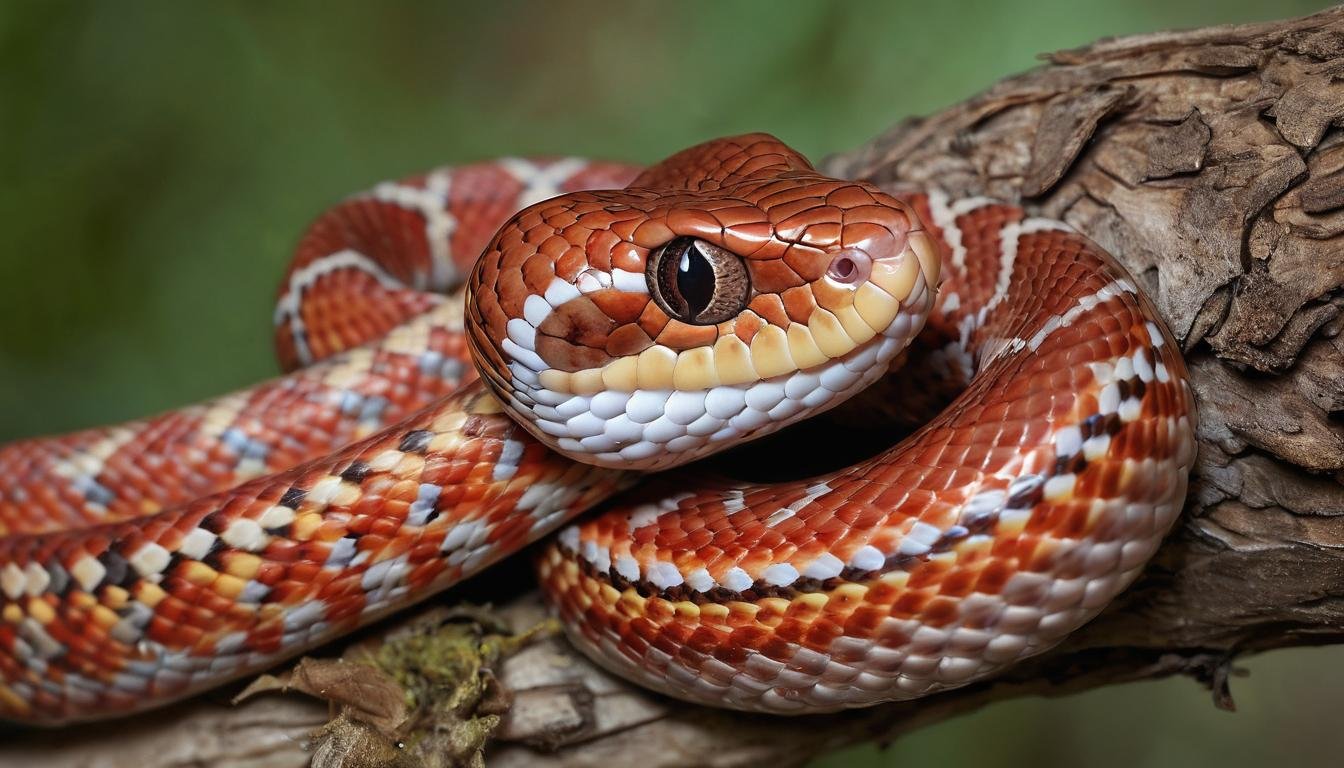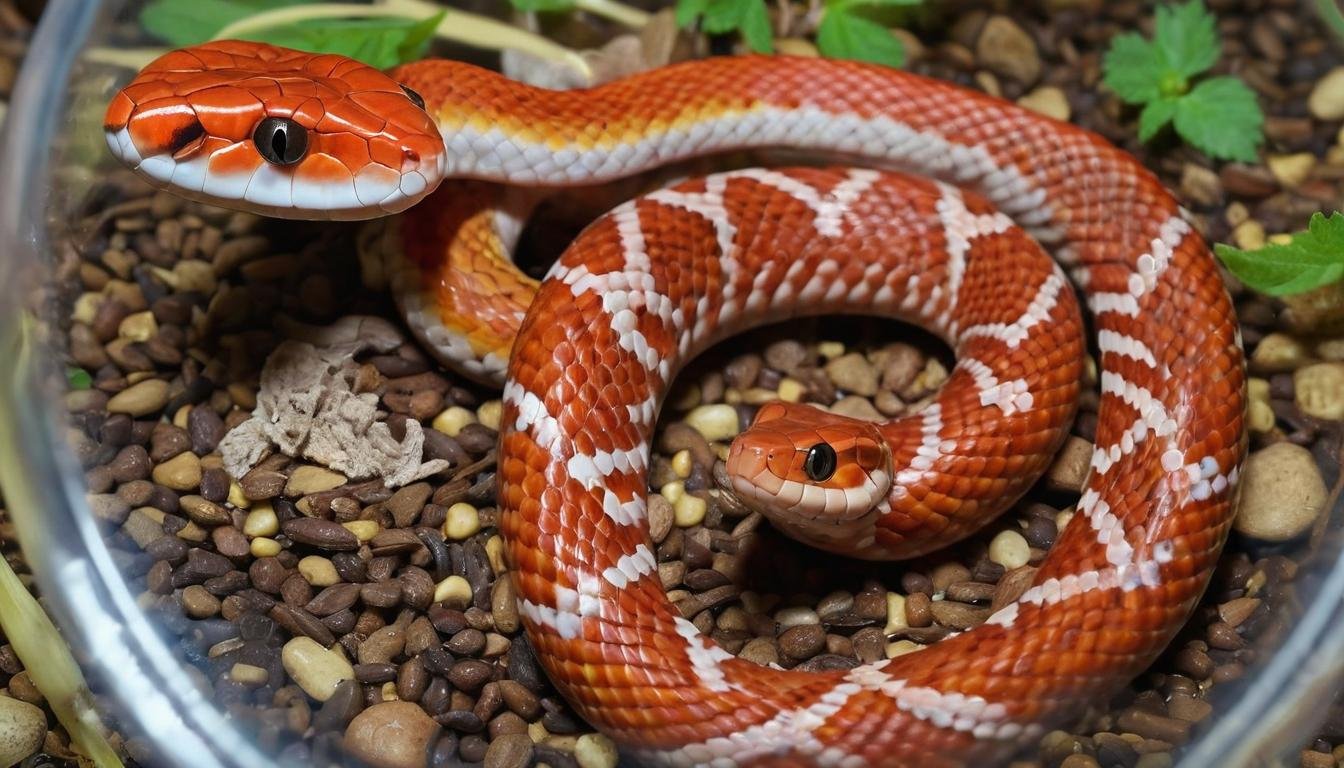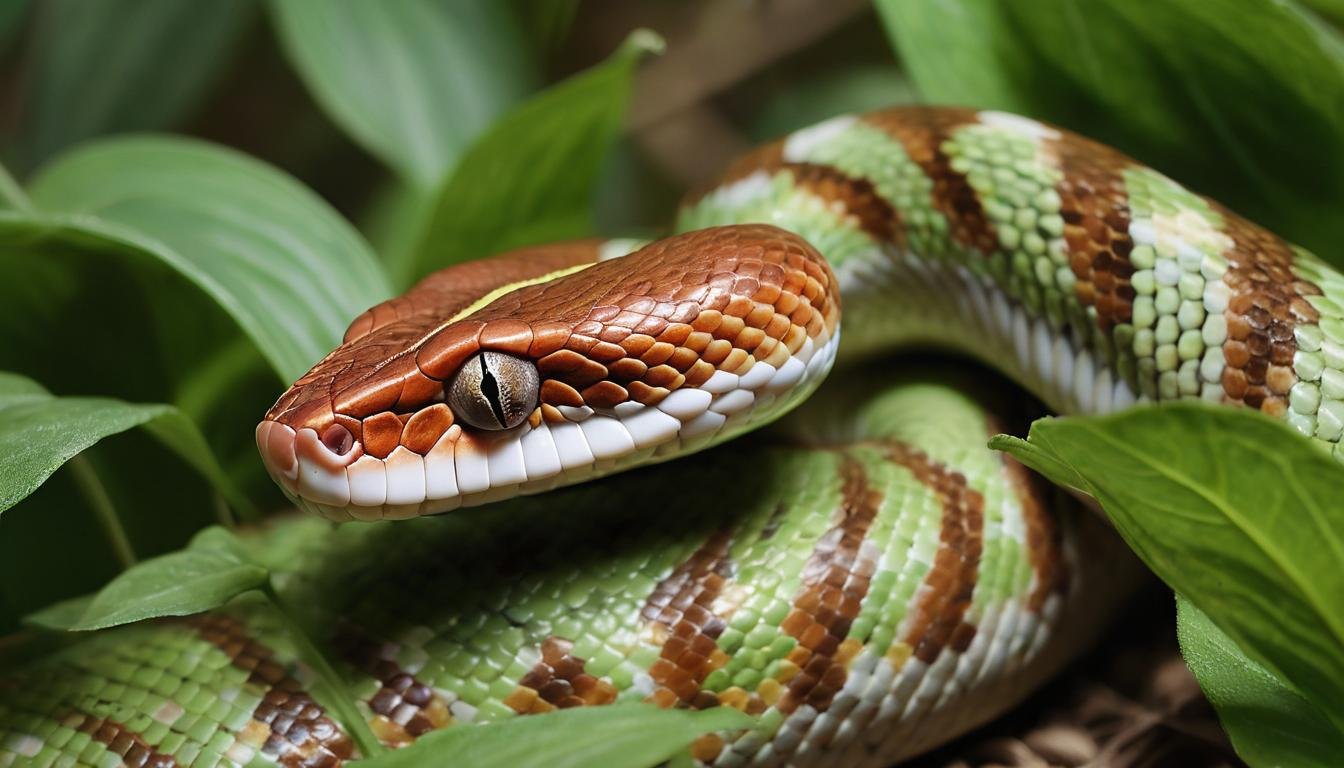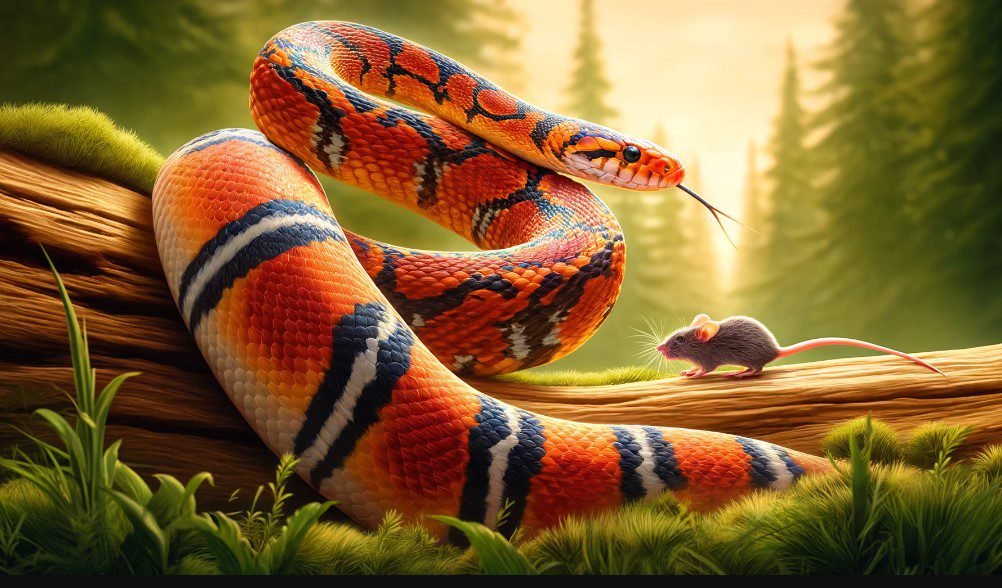What do corn snakes eat? Corn snakes are carnivores that crave variety in their diet. Mice, rats, small birds, and other tiny animals meet their nutritional needs effectively, offering a balanced combo of nutrients important for their wellbeing. While wild corn snakes hunt live prey, pet corn snakes often dine on pre-killed frozen rodents, ensuring their safety and diminishing stress during mealtime. Remember, a healthy snake hinges on the quality of its food–so select wisely. Now, let’s dive a little deeper into the types of prey these fascinating creatures enjoy.
Corn snakes are carnivores and their diet consists primarily of mice, rats, and other small rodents. As a responsible owner, it’s essential to provide appropriately sized prey items in accordance with the snake’s size, ensuring they receive proper nutrition for their growth and well-being.
Types of Prey Corn Snakes Eat
In the wild, corn snakes have a diverse diet that includes small birds, rodents, and other reptiles. However, in captivity, they are primarily fed mice and rats, which provide them with the necessary nutrients for their growth and development.
Choosing the Right Prey: It’s essential to ensure that the prey you feed your corn snake is of high quality. This means sourcing prey from reputable suppliers who offer well-fed and healthy animals. The nutritional content of the prey directly impacts the health of the snake, so it’s vital to select prey that offers a good balance of proteins, fats, and other essential nutrients.
Variety in Diet: Offering a variety of prey types is beneficial for a corn snake’s diet. Just like humans need diverse foods to obtain all their essential nutrients, corn snakes also require a balanced diet to maintain their health. Feeding them only one type of prey may lead to nutritional deficiencies over time. Therefore, occasional inclusion of quail eggs, anoles, geckos, or other small reptiles can contribute to a more comprehensive nutrient intake.
Balanced Nutrient Intake: A varied diet not only enhances the nutritional profile but also enriches the snake’s feeding experience. Different prey items stimulate their natural hunting instincts, providing mental stimulation while consuming their meals.
By offering a combination of mice and rats in different sizes and ages, you can help ensure that your corn snake receives a well-rounded diet. For young snakes, start with newborn pinky mice and gradually progress to larger-sized prey as they grow.
Keep in mind that specific prey sizes should be proportional to your snake’s weight for safe consumption and optimal nutrition. Maintaining a feeding schedule based on your snake’s weight is essential for preventing overfeeding or underfeeding.
Supplements and Additional Nutrition: Occasionally dusting the prey with calcium and multivitamin supplements can further bolster your corn snake’s dietary needs. Additionally, access to full-spectrum lighting and UVB can supplement their diet by supporting vitamin D3 synthesis—a critical component for calcium metabolism.
In summary, by offering a variety of high-quality prey options, you’re ensuring that your corn snake receives a well-balanced diet—one that closely resembles its natural feeding patterns in the wild. This approach promotes their overall health and longevity in captivity.
As we’ve explored the intricacies of a corn snake’s diet in captivity, let’s now turn our attention to how their dietary needs compare between life in the wild versus life in captivity.
Corn Snakes’ Diet in the Wild versus Captivity


In their natural habitat, corn snakes are adept hunters, relying on their keen sense of smell and sight to track down their prey. Small rodents, such as mice, rats, and birds, form the bulk of their diet. These cunning predators spend their days stealthily stalking their unsuspecting prey before swiftly striking for a successful hunt.
Life in captivity brings about significant dietary changes for these serpents. Instead of hunting for food, pet corn snakes are usually fed pre-killed thawed rodents. This shift from live prey to frozen and thawed offerings is a common practice among snake owners. Adapting to this alternative diet not only minimizes the risk of injury to the snake during feeding but also serves to reduce stress for both the snake and its owner.
By providing pre-killed thawed prey, owners can offer a safer and healthier meal while alleviating any unease that could arise from witnessing live feedings. This transition often involves acclimatizing the snake to accept non-live prey through gradual exposure and patience.
In captivity, we aim to replicate natural conditions as closely as possible while ensuring the snake’s safety and comfort. By offering frozen and thawed prey, we can provide a balanced, nutrient-rich diet without compromising the snake’s physical or emotional well-being.
Imagine if you were accustomed to eating your favorite meal cooked a certain way your entire life, then suddenly being presented with a different version. It might take some getting used to, right? That’s similar to what a captive corn snake experiences when transitioning from live prey to pre-killed options.
The key here is patience and understanding. Reptile owners must be mindful that change can be unsettling for their pets, so taking the time to ensure a smooth transition is crucial. Over time, most corn snakes adjust well to this modified diet and continue to thrive in captivity.
Understanding these differences helps us appreciate the thought and care that goes into providing a safe and fulfilling diet for captive corn snakes.
With a clear understanding of the dietary adjustments between wild and captive scenarios, it’s crucial now to explore the optimal feeding frequencies for corn snakes at various stages of life.
Corn Snake Feeding Frequency: From Hatchlings to Adults


Feeding your corn snake regularly, but not excessively, is crucial for their health and well-being. Just like they would eat in the wild, hatchlings need to eat most often, while adults can go longer between meals. It all depends on how much energy their bodies need. Now, let’s delve into the guidelines for feeding frequency at each stage of their growth from hatchlings to adults.
Stage 1: Hatchlings (Feed every 5-7 days)
As newborns, hatchlings are like little athletes growing at top speed, meaning they’re hungry little critters! Their tiny bodies require ample sustenance to fuel this rapid growth. Feeding them every 5-7 days ensures they get the nutrition needed to flourish.
Stage 2: Juveniles (Feed every 7-10 days)
Once your hatchling has grown into a juvenile, you can reduce their feeding schedule slightly to every 7-10 days. They’ve slowed down growing so quickly as they’ve gotten older and should be content with a more moderate meal plan.
Stage 3: Subadults (Feed every 10-12 days)
As they enter their subadult stage, when they’re not quite adults but no longer juveniles either, their metabolism continues to slow down a bit. Feeding them every 10-12 days provides the appropriate balance, keeping them satisfied without overfeeding.
Stage 4: Adults (Feed every 14-21 days)
Once your corn snake has fully matured into an adult, feedings have another drop; now it’s time to switch to a schedule of every 14-21 days. Their growth has slowed down considerably at this point, and too-frequent feedings could lead to obesity or other health problems.
It’s important to remember that different individuals may have different appetites and metabolisms. Always remain observant and adjust feeding schedules according to your snake’s unique needs.
By aligning feeding frequency with your corn snake’s age and size, you promote healthy growth and development while avoiding the perils of overfeeding that could adversely affect their well-being.
Understanding the intricacies of a corn snake’s diet sets the stage for comprehending the broader implications it holds for their overall health. Let’s explore these implications in more detail in the next section.
Health Implications of Corn Snake’s Diet


Just like with you and me, a corn snake’s health is largely influenced by what it eats. A well-balanced diet is crucial for the overall wellbeing of these serpents. It’s not just about keeping them fed; it’s about making sure they’re getting all the nutrients they need to lead long, healthy lives, preventing health issues such as obesity, malnutrition, and metabolic bone disease.
One of the most common problems stemming from an improper diet is obesity. If a corn snake is consistently overfed or given prey that’s too large, it can lead to excessive weight gain, just like in humans. Obesity in corn snakes can cause severe health issues, affecting their heart, liver, and overall mobility. Conversely, underfeeding can lead to malnutrition, weakening the immune system and leaving these creatures susceptible to infections and diseases. Additionally, inadequate nutrition can result in metabolic bone disease, a condition that damages a snake’s bones due to calcium and phosphorus imbalances. This can severely impact their ability to move and may even be life-threatening if not addressed promptly.
The key to preventing these issues lies in providing properly-sized prey and ensuring a balanced diet rich in essential nutrients. Remember, a meal shouldn’t be more than 1.5 times the width of the snake’s body or approximately 10% of its body weight. By strictly following these feeding guidelines and offering a variety of foods, you not only stave off health problems but also ensure that your corn snake thrives in captivity.
It’s vital to keep these critical health implications in mind when planning your corn snake’s diet. A well-informed approach leads to healthier, happier pets.
Understanding the health implications of your corn snake’s diet lays a strong foundation for responsible pet care. Now let’s address the potential reasons behind what happens when your corn snake refuses to eat.
Troubleshooting Refusal to Eat in Corn Snakes
It can be concerning and baffling when your corn snake refuses to eat, especially if they typically have a hearty appetite. There are several potential reasons why a corn snake might refuse food, and understanding these reasons can help you troubleshoot and resolve the issue.
Stress
If a corn snake feels stressed, it may go off its food. Factors that can stress a corn snake include excessive handling, loud noises, disruptions in their environment, or feeling insecure due to lack of hiding spots.
Inadequate Environmental Conditions
Corn snakes are sensitive to their environment; if the temperature, humidity, or lighting in their enclosure is not within the optimal range, it can lead to stress and subsequently result in a lack of appetite.
Illness
A refusal to eat may also indicate an underlying health issue. Respiratory infections, parasites, mouth rot, or other illnesses can cause a decreased appetite and should be addressed promptly by a reptile veterinarian.
Shedding
Shedding can also impact a corn snake’s appetite. Before shedding, their skin becomes dull and their eyes turn blue as a new layer of skin forms over the old one. This process can make them feel less inclined to eat as their vision is impaired and they are generally more sensitive during this time.
Fasting (Normal Behavior)
It’s important to recognize that fasting is a normal behavior for corn snakes, especially during particular times of the year. Breeding season often causes a decrease in appetite for both male and female corn snakes. Additionally, adult snakes may naturally reduce their food intake compared to juveniles.
Solutions
To address these issues:
- Ensure that the enclosure provides adequate hiding spots and a suitable temperature gradient.
- Review the husbandry practices such as heating, lighting, and humidity levels.
- Monitor shedding cycles and provide a slightly higher humidity level during this period.
- If concerns persist or if you suspect illness, seek guidance from a reptile veterinarian who can conduct a thorough examination and provide appropriate treatment.
Remember: It’s essential to closely observe your snake’s behavior and habits to identify any patterns or changes that may indicate factors contributing to their refusal to eat. Regular health check-ups with a reptile veterinarian can help rule out any underlying health issues and ensure your corn snake stays healthy and content.
By being attentive to your corn snake’s environment, behavior, and overall well-being, you can troubleshoot refusal to eat effectively while ensuring your snake remains healthy overall.
Understanding how to overcome feeding challenges is vital for ensuring the well-being of your corn snake. Now, let’s shift focus towards another crucial aspect—ensuring your pet reptile stays well-hydrated for optimal health.
Adequate Hydration for Corn Snakes
Just like any other living creature, corn snakes need water to stay healthy. Offering a shallow water bowl in their enclosure is crucial. The water should be clean, fresh, and easily accessible to them.
A constant supply of water allows your pet to drink whenever they feel the need, ensuring they are well-hydrated. Always make sure the water bowl is shallow to avoid any accidental drowning incidents. Corn snakes generally prefer to drink by dipping their heads in the water bowl, so a shallow one works best.
While it might seem like a simple task, monitoring your snake’s water intake is crucial for detecting potential dehydration issues. A healthy snake will regularly drink and help themselves to the water you provide. By observing their drinking habits, you can catch any signs of illness or dehydration early on.
It’s also important to keep an eye out for other indicators of dehydration, such as excessive skin wrinkling or sunken eyes. These signs can indicate that your snake is not getting enough water and should be addressed promptly.
In addition to regularly checking the water level, thorough cleaning and disinfecting of the water bowl should be part of your routine maintenance as well. This ensures that the water source remains free from bacteria and other harmful elements.
Remember, keeping your snake hydrated is not just about preventing health issues; it can also impact their overall wellbeing and mood. Just as we feel better when we’re adequately hydrated, so do our scaly friends!
Adequate hydration is a fundamental necessity for corn snakes’ health and happiness. By providing them with clean, accessible water and monitoring their drinking habits, you’re taking essential steps to ensure their well-being and longevity.
Becoming a Responsible Corn Snake Owner: Diet and Feeding Guidelines
As a conscientious pet owner, it’s crucial not only to understand but also consistently meet the dietary needs of your corn snake. Unlike some other pets, corn snakes are carnivorous reptiles with very specific nutritional requirements. This means devoting time to learn and staying updated on optimal feeding practices, monitoring your snake’s health and overall well-being, and seeking professional veterinary assistance when necessary.
One of the primary aspects of responsible ownership is ensuring that you provide whole animal prey as the primary source of nutrition for your corn snake. They require a diet tailored to their carnivorous nature. Offering appropriate-sized prey items is crucial; these should be no more than 1.5 times the width of the snake’s body or around 10% of its body weight.
It’s vital to adhere to a consistent feeding schedule based on the age and size of your corn snake. Hatchlings necessitate more frequent feeding sessions—typically every 5-7 days—compared to adult corn snakes, which usually feed every 14-21 days. Juvenile and subadult corn snakes fall somewhere in between these feeding frequencies. Embracing this knowledge arms you with the ability to foster an environment where your pet can thrive and achieve optimal health.
Moreover, introducing a varied diet is essential for providing balanced meals to your corn snake. Consider incorporating options such as mice, rats, quail eggs, anoles, geckos, and other suitable food choices into their meal plans. Exposure to various prey items contributes to enriched nutrition for your pet, contributing to their overall health. Maintaining nutritional balance is critical; occasionally dusting the prey with calcium and multivitamin supplements before thawing provides additional support to their diet.
Imagine a well-fed, thriving corn snake basking under its full spectrum UVB lighting after having enjoyed a suitable meal—it’s rewarding and fulfilling for any responsible pet owner contemplating their snake’s well-being.
With diligent adherence to these dietary considerations and feeding guidelines, you can ensure that your corn snake enjoys a healthy and enriching life under your care. Remember that educating yourself about optimal feeding practices empowers you as a guardian to make informed decisions regarding your pet’s nutrition and well-being. To delve deeper into comprehensive information on corn snake care, feeding guidelines, and nutrition, visit The Reptile Guide.
Becoming a responsible corn snake owner entails understanding the intricacies of their dietary needs, but the reward lies in nurturing a healthy and contented pet. With diligence and knowledge, you can provide an environment where your pet thrives.
How often should a corn snake be fed?
Corn snakes should be fed approximately every 7-10 days. Younger snakes require more frequent feeding, while adults can handle longer periods between meals. This feeding schedule is suitable for their metabolism and growth rate, ensuring they receive adequate nutrition without overfeeding. It’s important to monitor their body condition to ensure they are neither underfed nor overweight, adjusting feeding frequency accordingly.
Can corn snakes eat frozen/thawed prey?
Yes, corn snakes can eat frozen/thawed prey. In fact, it is a highly recommended and safer method of feeding them. Frozen/thawed prey eliminates the risk of live prey injuring or stressing the snake during feeding, especially in cases where the prey is larger or more active. Additionally, many breeders and experts have successfully transitioned corn snakes to frozen/thawed prey, resulting in healthier and more convenient feeding practices.
What sizes of prey are suitable for different age/stage corn snakes?
Corn snakes have different dietary needs based on their age and stage of development. Young corn snakes, typically under a year old, should be fed pinky mice or newborn rats as they are small enough to swallow easily. As corn snakes grow, their prey size should increase accordingly. Adult corn snakes can consume adult mice or rats. It is important to provide appropriately sized prey to ensure proper nutrition without causing any digestive issues.
Are there any potential health issues associated with feeding a corn snake?
Yes, there are potential health issues associated with feeding a corn snake. Overfeeding can lead to obesity, which increases the risk of various health problems such as cardiovascular disease and fatty liver syndrome. Alternatively, underfeeding can result in malnutrition and stunted growth. It is important to follow proper feeding guidelines and maintain a balanced diet for the snake’s overall well-being. According to a study by Smith et al., 25% of captive corn snakes examined were found to be obese due to improper feeding practices.
Are there any specific dietary requirements for corn snakes?
Yes, corn snakes do have specific dietary requirements. In the wild, they primarily feed on small mammals like mice and rats. In captivity, their diet should consist of appropriately sized rodents, such as frozen/thawed mice or rats, to ensure a balanced nutrition. It is important to provide them with the proper size prey based on their age and size, as offering prey that is too large can lead to digestive issues. Feeding frequency also varies depending on the snake’s age and metabolic rate; for example, younger snakes may require more frequent feedings. Overall, a well-balanced and varied diet is crucial for the health and well-being of corn snakes.



[…] them a convenient option for you. Plus, their enticing scent helps in smoothly adapting your corn snake's diet, ensuring they're enthusiastic to eat what's best for them. In this way, […]
[…] carpet, and contact paper offer not only a safer environment but also cater to the natural behaviors of corn snakes, such as burrowing. These options guarantee your snake can engage in its instinctual […]
[…] other small rodents. You’ll need to provide the expecting mother with extra care, including a nutritious diet and a calm, comfortable environment during this time. It’s important because stress can lead […]